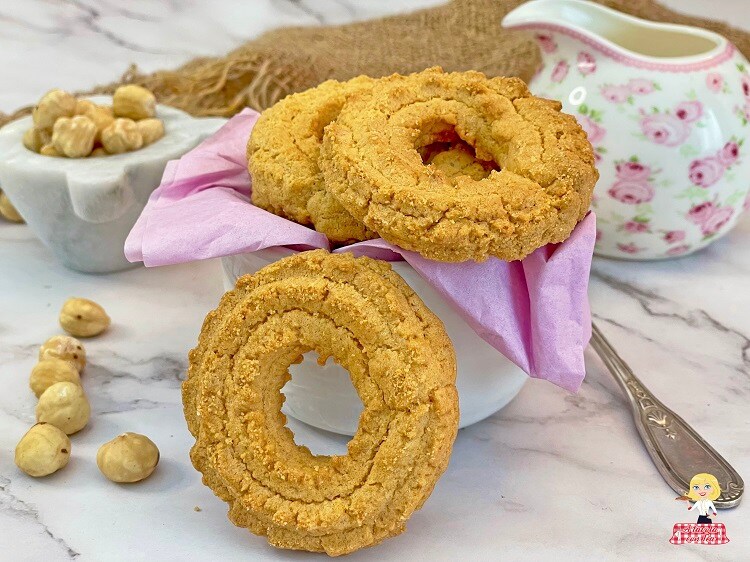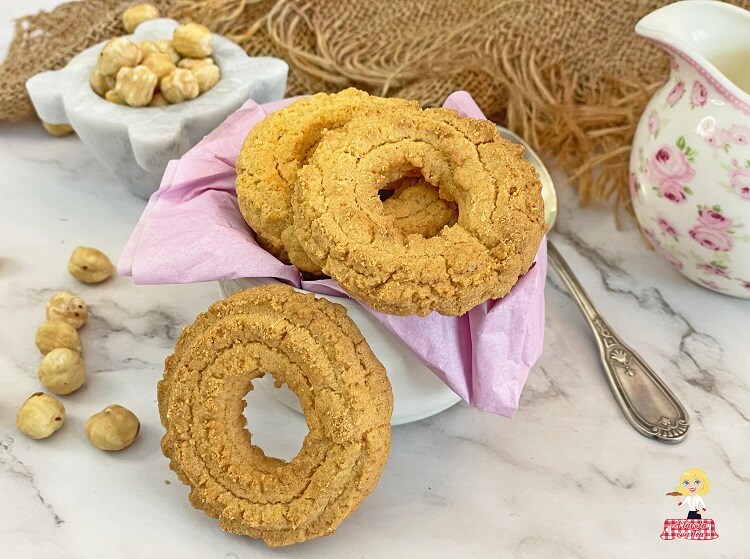I just returned from a weekend in Lower Piedmont, and every time I go there, I literally gorge on Paste di Meliga!
For those unfamiliar, Paste di Meliga are typical cookies from Piedmontese pastry, particularly from the Cuneo and Mondovì areas, made with fine cornmeal (called melia or meliga in Piedmontese dialect), butter, eggs, and sugar, characterized by a crumbly texture that melts in your mouth and a rustic appearance.
Like all traditional recipes, there are various versions; the one I propose today is not the classic Paste di Meliga but a variant with added hazelnuts that has literally conquered me and has almost replaced the original in my heart.
With my usual boldness, I didn’t hesitate to enter the pastry shop’s laboratory that offered them; I managed to get all the secrets of their recipe, which they kindly “adapted” for a homemade version. Now that I’ve replicated it, I can’t stop eating them!
It’s an easy preparation. The ingredients are simply whipped together into a soft and fluffy dough, which is then placed in a pastry bag and shaped into small round donuts with a somewhat rustic appearance.
No particular difficulty, just a simple tip: use very fine cornmeal, which will allow you to get a soft but not runny dough.
Paste di Meliga are, in my opinion, the best Piedmontese cookies available, and in the hazelnut variant, they are truly irresistible with their crumbliness, the slight crunchiness from the cornmeal, and an intoxicating hazelnut aroma that emerges during baking.
A unique delight with ancient origins: it is said they were created when, due to an increase in wheat prices, bakers began mixing cornmeal with the more expensive and rarer ’00’ flour.
From a necessity at the time, they evolved into a true staple of Piedmontese pastry loved throughout Italy.
Prepare these delicious Piedmontese Cookies Paste di Meliga. Perfect for any occasion, you can enjoy them with a cup of tea, dip them in milk for breakfast, or in hot chocolate for a snack, serve them as dessert dipped in zabaione, at the end of a meal paired with a glass of Moscato, and they are also ideal to pack and give as Christmas gifts because once ready, they keep for a long time!
Follow the recipe and see the results.
Here are some other cookie recipes for you

- Difficulty: Easy
- Cost: Very cheap
- Preparation time: 30 Minutes
- Portions: about 40 cookies
- Cooking methods: Oven
- Cuisine: Italian
- Energy 285.05 (Kcal)
- Carbohydrates 31.05 (g) of which sugars 14.22 (g)
- Proteins 4.18 (g)
- Fat 16.61 (g) of which saturated 7.68 (g)of which unsaturated 4.75 (g)
- Fibers 0.88 (g)
- Sodium 7.99 (mg)
Indicative values for a portion of 60 g processed in an automated way starting from the nutritional information available on the CREA* and FoodData Central** databases. It is not food and / or nutritional advice.
* CREATES Food and Nutrition Research Center: https://www.crea.gov.it/alimenti-e-nutrizione https://www.alimentinutrizione.it ** U.S. Department of Agriculture, Agricultural Research Service. FoodData Central, 2019. https://fdc.nal.usda.gov
Ingredients
- 1 2/3 cups cornmeal (fine)
- 1 1/4 cups all-purpose flour
- 14 tbsp butter
- 1 1/4 cups hazelnut flour (or toasted hazelnuts)
- 1 cup brown sugar (raw)
- 1 tsp baking powder
- 1/4 cup eggs
- 1 egg yolk (1 oz)
- 1 vanilla bean (the seeds)
- 1/2 lemon (untreated, grated zest)
Tools
- Bowl
- Stand Mixer
- Hand Whisk
- Pastry Bag
- Baking Tray
Steps
First, place the hazelnut flour (you can also use hazelnuts and grind them in the mixer with the sugar to make flour) and the sugar in a bowl and mix with a spoon. Whip the butter at room temperature (between 64°F and 68°F) with the stand mixer along with the hazelnut flour and sugar mixture, then add the vanilla bean seeds and lemon zest.
At this point, incorporate the egg yolks and the egg, finally the cornmeal and all-purpose flour with the baking powder. The dough does not require resting and can be immediately placed in the pastry bag fitted with a medium-large star nozzle. Cover a baking tray with parchment paper and start forming the classic donut shape typical of Paste di Meliga. If you don’t have a pastry bag but have a cookie press, use it, choosing your preferred shape.
After shaping the cookies, cover them with food-grade plastic wrap and place them in the refrigerator for an hour or alternatively in the freezer for half an hour (this will help them not to deform during baking). Bake the Piedmontese Cookies Paste di Meliga in a preheated oven at 356°F for about 20/25 minutes until they have a nice golden color.

STORAGE
The Piedmontese Cookies Paste di Meliga can be stored in a tin box or glass jar for up to 2 weeks.
HISTORY AND CURIOSITIES OF PASTE DI MELIGA
The origins of the Piedmontese Cookies Paste di Meliga are very ancient, though hard to date, and are rooted in the peasant culture of the Mondovì area in the province of Cuneo.
To cope with the excessive increase in the cost of all-purpose flour, bakers started mixing it with “corn flour“, which is the finely ground corn flour normally used to make polenta.
This improvised recipe to deal with a moment of crisis gave birth to the Paste di Meliga, a melt-in-the-mouth cookie with a crumbly taste conferred precisely by this particular flour.

